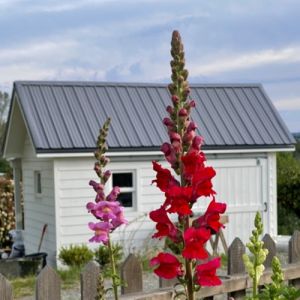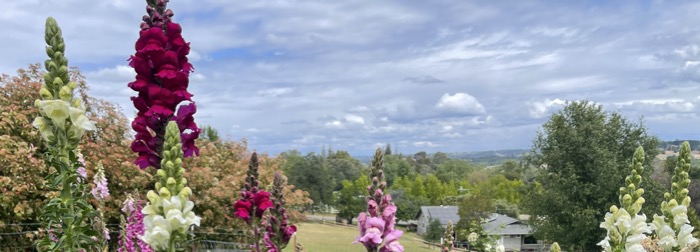A vertical element for any garden
Welcome to the vibrant world of Snapdragons, also known as Antirrhinum. In this blog post, we explore everything about Snapdragons, diving into their origin, varieties, planting tips, and care. These charming flowers, with their rich colors and unique shapes, make a fantastic addition to any garden.
Origins and Features
Snapdragons find their roots in the rocky areas of Europe, the United States, and North Africa. The name comes from the flower’s resemblance to a dragon’s mouth, which opens and closes when the sides are gently squeezed. Available in sizes ranging from dwarf varieties perfect for borders to taller types ideal for the back of a flower bed, Snapdragons are versatile and eye-catching.
Colorful Varieties
These flowers boast a wide array of colors, including white, yellow, pink, red, orange, peach, purple, and even bicolored patterns. Popular varieties include the ‘Rocket’ Series, known for their tall spikes and extensive color range; the ‘Montego’ Series, compact and bushy, great for containers; and the ‘Twinny Peach’, a butterfly-type Snapdragon with double flowers in shades of peach.
Ideal Growing Conditions
Thriving in cooler temperatures, Snapdragons do best in full sun to partial shade. They are well-suited for USDA Hardiness Zones 7-11. These plants prefer well-draining soil and regular watering, especially during dry periods.
Planting Snapdragons
- Timing – Plant in spring after the frost risk is over. In warmer climates, fall planting is also effective.
- Soil Preparation – Opt for a sunny spot with well-drained soil, enriching it with compost or organic matter.
- Spacing – Allow 6-12 inches between plants for growth and air circulation.
- Watering – Maintain evenly moist soil, particularly in hot and dry conditions.
Snapdragons – A Primary Element of the Cottage Garden
Snapdragons, with their rich colors and distinctive shape, are a primary element in the quintessential cottage garden. Their role in these charming and informal garden spaces cannot be overstated, as they bring both aesthetic appeal and practical benefits.
Visual Appeal and Variety
Snapdragons add a burst of color and texture to the cottage garden. Their range of hues – from soft pastels to vibrant reds and yellows – allows them to blend seamlessly with the traditional cottage garden palette. The varied heights of Snapdragons, from the compact to the tall, contribute to the layered look that is a hallmark of cottage gardening. They create an engaging visual tapestry when planted alongside other cottage garden favorites like roses, foxgloves, and delphiniums.
Versatility in Planting
One of the charms of cottage gardens is their informal, slightly wild appearance, and Snapdragons fit this style perfectly. They can be planted in borders, used to fill gaps, or even grown in containers. Their ability to grow in a variety of conditions, from full sun to partial shade, makes them an adaptable choice for many garden areas.
Attraction for Pollinators
A cottage garden is not only about beauty but also about creating a habitat for wildlife, and Snapdragons excel in attracting pollinators. Their flowers are a magnet for bees, butterflies, and other beneficial insects, contributing to the health and vibrancy of the garden ecosystem.
Long Blooming Season
Snapdragons have a long flowering period, which ensures that the cottage garden remains colorful and dynamic from spring into late fall. This extended blooming season is particularly beneficial in maintaining the garden’s visual appeal throughout the growing months.
Easy to Grow and Maintain
Cottage gardens are often admired for their lush, overflowing look, which belies their relatively easy maintenance. Snapdragons fit right into this concept. They are hardy and relatively easy to care for, requiring only basic watering, occasional feeding, and deadheading to encourage continuous blooming.
Self-Seeding Properties
Snapdragons can self-seed under the right conditions, which adds to the charm of a cottage garden. This self-seeding capability allows the garden to evolve naturally over time, with delightful surprises in color and placement in subsequent seasons.
Care and Maintenance
- Deadheading – Remove spent flowers regularly to promote more blooming.
- Fertilization – Use a balanced, slow-release fertilizer at the start of the season.
- Pest Control – Watch for pests like aphids and caterpillars and manage as needed.
Cutting and Arranging
Snapdragons are excellent for cutting. Do this early in the morning when the first few flowers on the lower spike have opened, and place them in water immediately for a lasting display.
Conclusion
Snapdragons bring delight to any garden with their burst of color, unique shape, and charm. Whether in borders, containers, or as cut flowers, these versatile blooms bring joy and vibrancy to outdoor spaces. With the right conditions, they offer stunning beauty throughout the season.
Recent Posts

The Advantages of Built-Up Garden Beds: A Gardener’s Best Friend

The Secret Weapon for Lush Blooms: How to Create the Perfect Fertilizer Schedule

Create a Stunning Cottage Garden with These Easy-to-Grow Flowers

Fastest Growing Trees: Transform Your Landscape Quickly

What to Plant in July: A Comprehensive Guide for Gardeners













You must be logged in to post a comment.